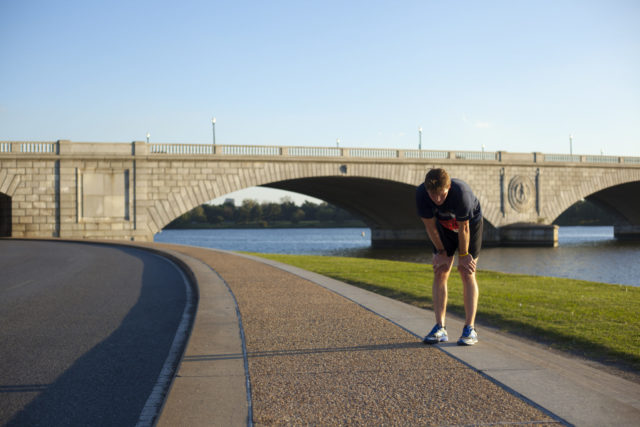
As soon as runners cross a starting line, they have big ideas as to what their finishes will look like. It could be a fast time, a new personal best, an epic photo finish or the idea of hugging a loved one at the end. Whatever the motivators may be, they’re powerful.
But there are some runners who are unable to cross the finish line. Because of weather, injury, time cut-offs, poor training, mental blocks or other issues, some runners drop out and take a DNF, Did Not Finish.
After race registration fees and months of training, it’s hard to fathom the idea of not finishing a race.
“Running should be fun and enjoyable,” said Kathy Pugh, a D.C.-based holistic health and running coach. “And if it’s not, what’s the worst thing that could happen? A DNF is not the end of the world. It’s annoying, it’s a frustration.”
It can be easy for a runner to intertwine their self-worth with their times, making a DNF that much harder to swallow.
“It does not define you as a person,” Pugh said.
Having dealt with her own DNF, Pugh believes it has made her a better coach. She’s able to empathize with her runners and teach them that although the race may be unfinished, those miles still count.
“There is always going to be another race,” Pugh said. “This is something that you learn from and reflect from…. Everyone has a bad day and sometimes that day happens at the end of a race.”
But if a runner is dealing with negative thoughts in the middle of the race, keep going, she said. “You’re going to feel worse if you didn’t.”
Four local runners shared stories that show a DNF is not a black mark, but instead a learning tool to aid them throughout their running careers.
The Injury
Just weeks before the Marine Corps Marathon in 2014, George Shonat of Arlington, Va. noticed his foot was completely bloody after a long run. He removed his shoe and saw that a toenail had dug into one of his toes. Shonat shrugged it off, but the next day, his entire foot ached from plantar fasciitis. The pain wouldn’t go away.
About two weeks later, Shonat raced the Army Ten-Miler but wasn’t sure how the race was going to go because his foot was still in some pain. But he wanted to give it a try anyway.
“By mile two or three, I noticed my foot was hurting,” he said. “By mile four my foot was in excruciating pain.”
He walked to the nearest first aid tent, where medics attended to him. He did not run the upcoming marathon. His foot was “out of commission.” He recalls not even being able to do yoga.
It was a double whammy–pulling out of the 10-mile race and not being able to run the marathon.
“I called it quits at the right time,” Shonat said. “I knew it sucked to drop out of the race, but I heard horror stories from people needing surgeries from plantar fasciitis. And I didn’t want that.”
His foot took six months to heal. Although that process was hard, he never thought of this DNF as a negative on his running career.
“I want to stay healthy enough in the long run rather than trying to go all out for the Ten-Miler or the Marine Corps,” he said. “I’m only 30 years old. I don’t want my running career to end.”
It’s Never Too Late, Until It Is
The 2014 JFK 50 Mile was going to be Chateau Mangaroo‘s debut as an ultrarunner. The course, which starts in Boonsboro, Md., is known for rugged, technical hills on the Appalachian Trail, over 1,100 feet of gained elevation in just the first six miles and a 26-mile stretch on the C&O Canal Towpath. And because it takes place in November, it’s notoriously windy and cold. That all worked against Mangaroo.
“Instead of moving on the trail with a purpose, I kind of just walked it and lollygagged,” Mangaroo, 41, said. “I remember thinking, ‘I can take my time in the beginning, but I can make it up on the flat.'”
The Arlington resident did not make the time cut-off at mile 27, but she continued running until mile 38. She ran for 11 miles, knowing she was done.
“The biggest thought was that I was never going to attempt this again,” Mangaroo said. “It’s too cold, too much training and just too far.”
What was hardest, she said, was seeing other participants in their race shirts and medals. Although she had a shirt too, it acted as a reminder that she didn’t finish the race. Mangaroo left the shirt in her hotel room.
“I’ve been running for well over 20 years, so I was able to get over it,” she said. “I didn’t linger on it as much as I thought I would, but there was some processing.”
But she couldn’t let go of the race. This was the one ultra she really wanted to complete. So, the following year, she tried one more time (as runners often do). With a better plan and weather, she completed it in just over 11 hours, beating the 12-hour cutoff.
Throughout Mangaroo’s running career, she had several other DNFs, but the 2014 JFK 50 Mile made a significant impact. Her other incompletions were because she didn’t meet a training goal and stopped the races a bit short. But with the JFK race, her only goal was to finish. Looking back, she thinks it could have been avoided.
“We learn more from failure than we do from success,” she said. “I didn’t control my DNF. I didn’t finish because I couldn’t meet the time. What it taught me the most was training the way you plan on racing.”
Exuberant Ambition
Kerry Allen has quite the running resume with three half-marathon wins in 2017 alone, but her recent efforts also include two uncompleted marathons. The problems started at the end of the 2016 racing season, at the New York City Marathon.
Allen, a D.C. resident, started the run excited and confident. She hoped to smash a 2:43 marathon. At the halfway point, she checked her paces and realized she was working a little bit harder than she should have been. She also started to feel some pain at the bottom of her right foot.
While heading into Manhattan after the Queensboro Bridge, she had trouble breathing and the foot pain became unbearable. She stopped at mile 16.
“That was really disappointing. It took me a few days of wallowing to get over it,” Allen said.
Her second DNF of the season came at the 2017 Grandma’s Marathon in Minnesota. Allen, 29, was training for shorter distances but registered for the race anyway. She considered it “a gamble” because she was undertrained, so when she didn’t cross the finish line, she didn’t feel too bad. With hot, humid conditions striking for the second year in a row, Allen’s race ended with her vomiting and dry heaving on the side of the road.
“This shows what a tricky distance the marathon is, and how a little bit of bad luck can go a long way,” Allen said. “My main goal in running is for it to bring me happiness. But I’ve learned that I don’t feel the need to subject myself to those ultra-miserable experiences.”
Her other big wins, including at the Rock ‘n’ Roll Washington DC in March, helped soften the blows, she said. Allen’s next 26.2 will be the California International Marathon in December, and she hopes to qualify for the U.S. Olympic marathon trials.
“If I hit that, I think it’s safe to say that I’ve completely gotten over the DNF,” Allen said.
A Foundation in Disguise
Marisa Carden of Northern Virginia has a unique perspective on her DNF.
“I think the DNF is pretty rad. I had ambitions out to have an unblemished record, but I think that DNF makes me a better runner,” Carden, 27, said. “Instead of looking at it as a failure, it revealed to me what my limits were, so now I can push them further.”
That’s not to say she didn’t struggle. When she knew she wasn’t going to complete the 2017 Quest for the Crest, she says, she felt like “a shitty runner.”
“That was my immediate thought,” she said. “It kept going through my head that I was a shitty runner. And I would eventually have to divulge to people that I didn’t get to finish my race.”
She’d have to admit she wasn’t fast enough.
This spring, the newbie ultrarunner set out to complete the Quest for the Crest, a rugged 50K tucked in the mountains of Burnsville, N.C. The race boasts 11,300 feet of elevation gains, 11,700 feet of elevation loss and a low finish rate.
Carden knew it was an ambitious goal. Maybe it was poor race-day execution, a sprained ankle just before the race or a late start to elevation training, but the race did not go according to plan, she said.
“I got to a little over 19 miles, about 7,000 feet of elevation and it took me eight hours to do,” she said. “I timed out and was an hour behind schedule.”
The DNF made her really doubt her running abilities, and she was dreading telling people that she was unable to finish the race.
What was most awkward, Carden said, was the morning after the race: in the tiny host town, finishers and race shirts surrounded her. It was incredibly disheartening, she said, to see all these runners and hear them talk of their accomplishments.
Despite the challenges, Carden needed closure; she needed to conquer Mount Mitchell, the hill she never was able to crest. She spent the next several months doing extreme elevation training and mileage gains. In July, she rounded up some of her running buddies and they made the trek back to North Carolina.
“The ultimate closure was going back to that exact spot where I had to exit the course. I got to climb up the hill instead of going down,” she said. “There was no way I could wait until next year to finish this course.”
Now, Carden feels much more at peace and plans on tackling this race again come 2018.
“Registration opens in October and I have an alarm set on my phone!”
Recent Stories
Looking for our race calendar? Click here Submit races here or shop local for running gear
Zebra Dazzle 5k Walk/Run or 100 Bike over 30 Days
Join the Zebras for this Zebra Dazzle event for all fitness levels. The 5k Walk/Run has 2 options. You can participate as an onsite participant on 9/13 at Carter Barron in Rock Creek Park, NW Washington DC or as a
Hero Dogs 5K9
Hero Dogs Inc will host its 5th Annual 5K9 race at the Congressional Cemetery on Saturday, May 17th, beginning at 8 am. There will also be a 1K Fun Run. The 1K Fun Run will start at 8 am sharp






